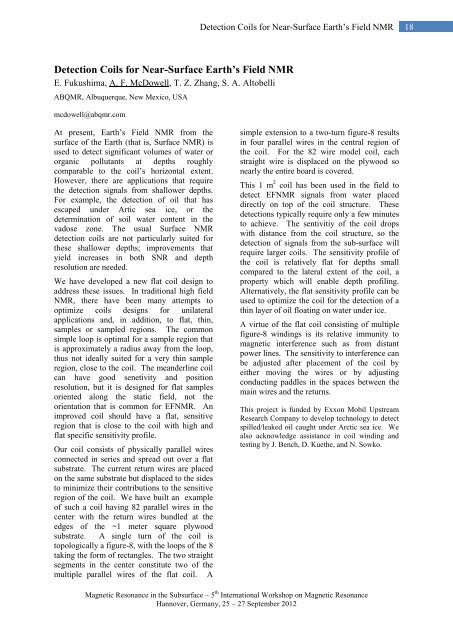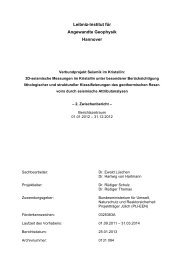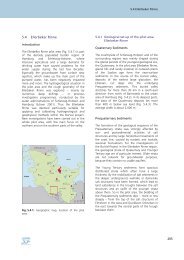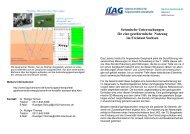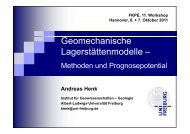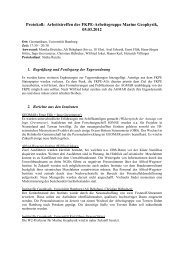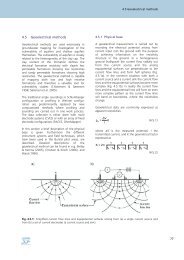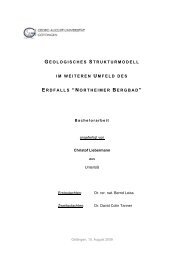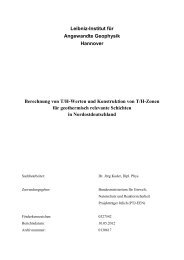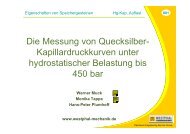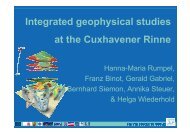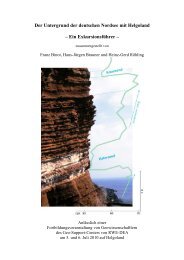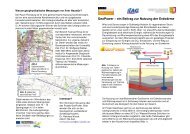Magnetic Resonance in the Subsurface – 5th International ... - LIAG
Magnetic Resonance in the Subsurface – 5th International ... - LIAG
Magnetic Resonance in the Subsurface – 5th International ... - LIAG
Create successful ePaper yourself
Turn your PDF publications into a flip-book with our unique Google optimized e-Paper software.
Detection Coils for Near-Surface Earth’s Field NMR<br />
E. Fukushima, A. F. McDowell, T. Z. Zhang, S. A. Altobelli<br />
ABQMR, Albuquerque, New Mexico, USA<br />
mcdowell@abqmr.com<br />
At present, Earth’s Field NMR from <strong>the</strong><br />
surface of <strong>the</strong> Earth (that is, Surface NMR) is<br />
used to detect significant volumes of water or<br />
organic pollutants at depths roughly<br />
comparable to <strong>the</strong> coil’s horizontal extent.<br />
However, <strong>the</strong>re are applications that require<br />
<strong>the</strong> detection signals from shallower depths.<br />
For example, <strong>the</strong> detection of oil that has<br />
escaped under Artic sea ice, or <strong>the</strong><br />
determ<strong>in</strong>ation of soil water content <strong>in</strong> <strong>the</strong><br />
vadose zone. The usual Surface NMR<br />
detection coils are not particularly suited for<br />
<strong>the</strong>se shallower depths; improvements that<br />
yield <strong>in</strong>creases <strong>in</strong> both SNR and depth<br />
resolution are needed.<br />
We have developed a new flat coil design to<br />
address <strong>the</strong>se issues. In traditional high field<br />
NMR, <strong>the</strong>re have been many attempts to<br />
optimize coils designs for unilateral<br />
applications and, <strong>in</strong> addition, to flat, th<strong>in</strong>,<br />
samples or sampled regions. The common<br />
simple loop is optimal for a sample region that<br />
is approximately a radius away from <strong>the</strong> loop,<br />
thus not ideally suited for a very th<strong>in</strong> sample<br />
region, close to <strong>the</strong> coil. The meanderl<strong>in</strong>e coil<br />
can have good senetivity and position<br />
resolution, but it is designed for flat samples<br />
oriented along <strong>the</strong> static field, not <strong>the</strong><br />
orientation that is common for EFNMR. An<br />
improved coil should have a flat, sensitive<br />
region that is close to <strong>the</strong> coil with high and<br />
flat specific sensitivity profile.<br />
Our coil consists of physically parallel wires<br />
connected <strong>in</strong> series and spread out over a flat<br />
substrate. The current return wires are placed<br />
on <strong>the</strong> same substrate but displaced to <strong>the</strong> sides<br />
to m<strong>in</strong>imize <strong>the</strong>ir contributions to <strong>the</strong> sensitive<br />
region of <strong>the</strong> coil. We have built an example<br />
of such a coil hav<strong>in</strong>g 82 parallel wires <strong>in</strong> <strong>the</strong><br />
center with <strong>the</strong> return wires bundled at <strong>the</strong><br />
edges of <strong>the</strong> ~1 meter square plywood<br />
substrate. A s<strong>in</strong>gle turn of <strong>the</strong> coil is<br />
topologically a figure-8, with <strong>the</strong> loops of <strong>the</strong> 8<br />
tak<strong>in</strong>g <strong>the</strong> form of rectangles. The two straight<br />
segments <strong>in</strong> <strong>the</strong> center constitute two of <strong>the</strong><br />
multiple parallel wires of <strong>the</strong> flat coil. A<br />
Detection Coils for Near-Surface Earth’s Field NMR<br />
simple extension to a two-turn figure-8 results<br />
<strong>in</strong> four parallel wires <strong>in</strong> <strong>the</strong> central region of<br />
<strong>the</strong> coil. For <strong>the</strong> 82 wire model coil, each<br />
straight wire is displaced on <strong>the</strong> plywood so<br />
nearly <strong>the</strong> entire board is covered.<br />
This 1 m 2 coil has been used <strong>in</strong> <strong>the</strong> field to<br />
detect EFNMR signals from water placed<br />
directly on top of <strong>the</strong> coil structure. These<br />
detections typically require only a few m<strong>in</strong>utes<br />
to achieve. The sentivitiy of <strong>the</strong> coil drops<br />
with distance from <strong>the</strong> coil structure, so <strong>the</strong><br />
detection of signals from <strong>the</strong> sub-surface will<br />
require larger coils. The sensitivity profile of<br />
<strong>the</strong> coil is relatively flat for depths small<br />
compared to <strong>the</strong> lateral extent of <strong>the</strong> coil, a<br />
property which will enable depth profil<strong>in</strong>g.<br />
Alternatively, <strong>the</strong> flat sensitivity profile can be<br />
used to optimize <strong>the</strong> coil for <strong>the</strong> detection of a<br />
th<strong>in</strong> layer of oil float<strong>in</strong>g on water under ice.<br />
A virtue of <strong>the</strong> flat coil consist<strong>in</strong>g of multiple<br />
figure-8 w<strong>in</strong>d<strong>in</strong>gs is its relative immunity to<br />
magnetic <strong>in</strong>terference such as from distant<br />
power l<strong>in</strong>es. The sensitivity to <strong>in</strong>terference can<br />
be adjusted after placement of <strong>the</strong> coil by<br />
ei<strong>the</strong>r mov<strong>in</strong>g <strong>the</strong> wires or by adjust<strong>in</strong>g<br />
conduct<strong>in</strong>g paddles <strong>in</strong> <strong>the</strong> spaces between <strong>the</strong><br />
ma<strong>in</strong> wires and <strong>the</strong> returns.<br />
This project is funded by Exxon Mobil Upstream<br />
Research Company to develop technology to detect<br />
spilled/leaked oil caught under Arctic sea ice. We<br />
also acknowledge assistance <strong>in</strong> coil w<strong>in</strong>d<strong>in</strong>g and<br />
test<strong>in</strong>g by J. Bench, D. Kue<strong>the</strong>, and N. Sowko.<br />
<strong>Magnetic</strong> <strong>Resonance</strong> <strong>in</strong> <strong>the</strong> <strong>Subsurface</strong> <strong>–</strong> 5 th <strong>International</strong> Workshop on <strong>Magnetic</strong> <strong>Resonance</strong><br />
Hannover, Germany, 25 <strong>–</strong> 27 September 2012<br />
18


